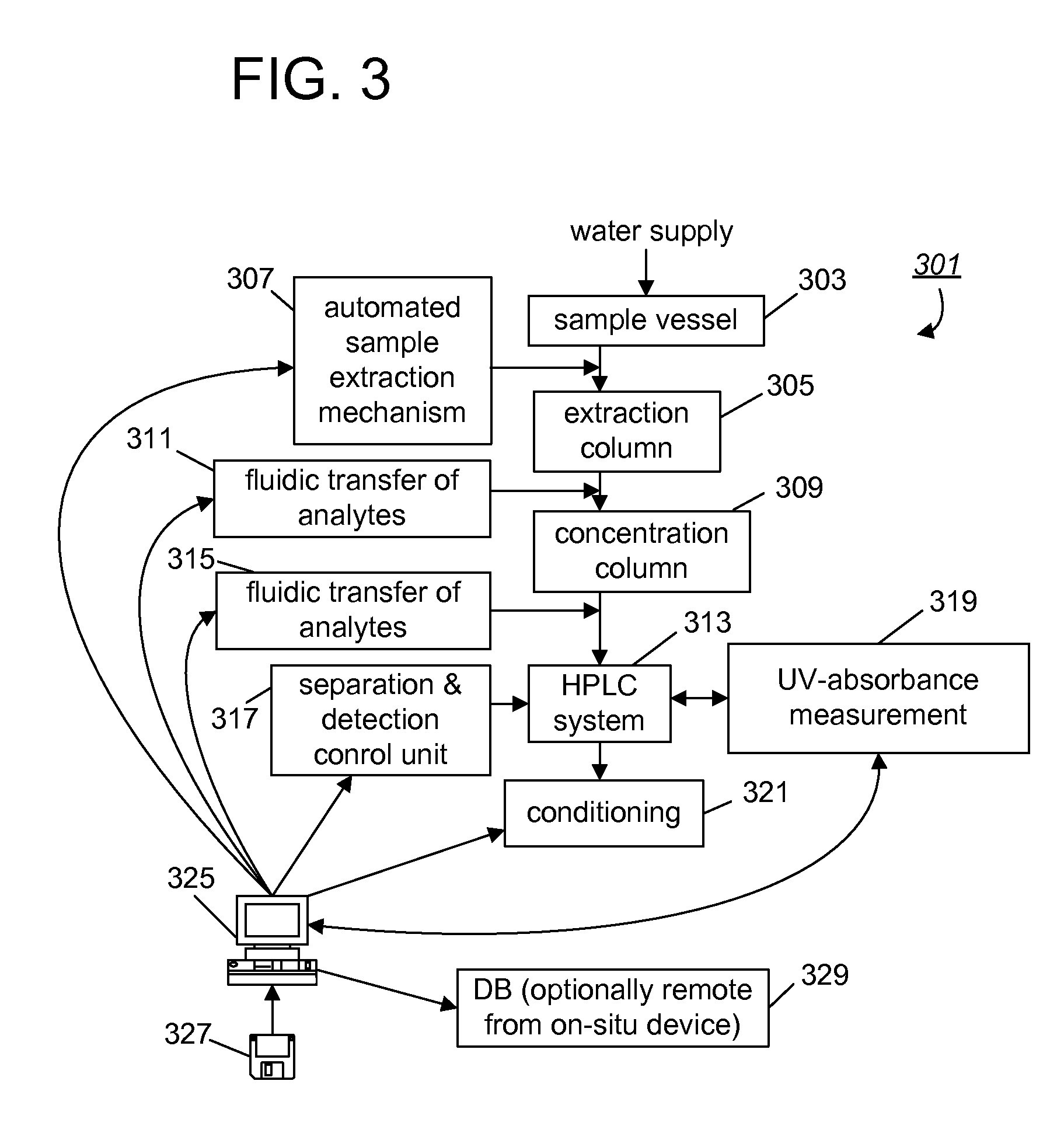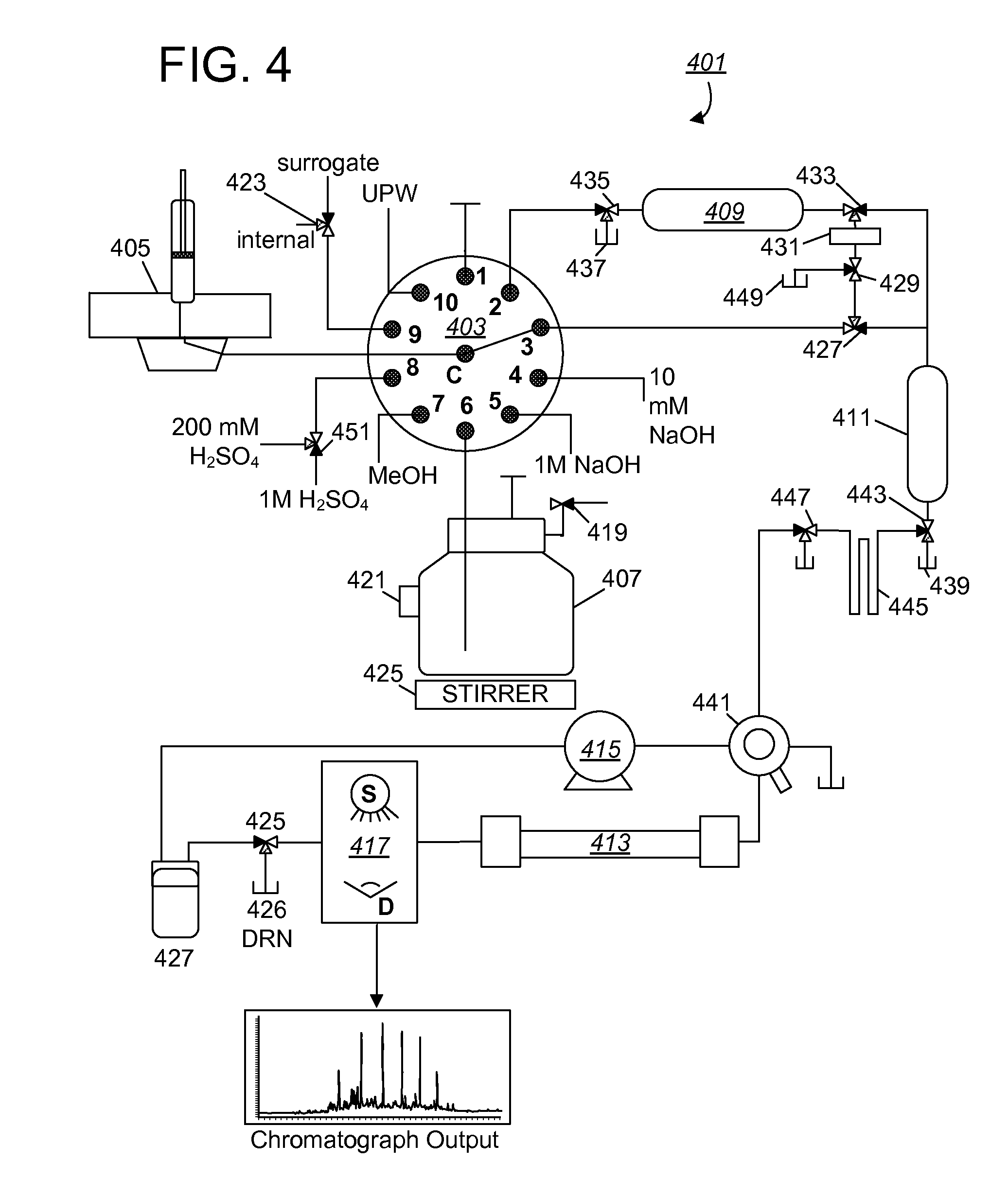Method and apparatus for determination of haloacetic acid (“HAA”) presence in aqueous solution
a technology of haloacetic acid and aqueous solution, which is applied in the direction of material analysis, testing water, instruments, etc., can solve the problems of inability to reliably and reproducibly achieve the required detection limits of most of these techniques, laborious and time-consuming pre-concentration techniques, and adverse reproductive and developmental effects in human beings. , to achieve the effect of low cos
- Summary
- Abstract
- Description
- Claims
- Application Information
AI Technical Summary
Benefits of technology
Problems solved by technology
Method used
Image
Examples
second embodiment
[0022]A second embodiment provides an in-situ mechanism that performs some or all of the steps or mechanisms just identified. The in-situ mechanism performs localize sample extraction and sample concentration for purpose of testing. In a more detailed embodiment, the in-situ mechanism also provides for localized separation and chromatographic analysis, and digitization of results. The in-situ mechanism in one more detailed embodiment includes mechanisms for calibration and standardization, providing for accurate results, normalized against known samples. An on-board LC system with automated control is optionally used for this purpose. The digitized results are processed by on-board logic, or they can be transmitted via a local or wide area network (e.g., a LAN or a WAN such as the Internet) to a remote computer for analysis.
[0023]Optionally employed together, the methods and in-situ mechanism provide for automated monitoring and compliance, with real-time feedback to ensure maintena...
embodiment 101
[0025]FIG. 1 provides a block diagram of an embodiment 101 of a method and system for measuring HAAs. A sample is first processed to extract at least one haloacetic acid to an adsorbent medium, as indicated by step 103. After being extracted on the adsorbent medium, the haloacetic acid is transferred to a concentration medium, as referenced by numeral 105. The analytes are eluted from the concentration medium and introduced into a chromatography system for separation, as indicated by step 107. This system is optionally a high-performance liquid chromatography system, as indicated by the acronym “HPLC.” As depicted by reference numeral 109, the separated HAAs are measured by exposing an extracted, concentrated sample to ultraviolet (UV) radiation, and by determining UV-absorbance using an optical spectrometer. Based on the measured absorbance results, haloacetic acid concentration is determined, as indicated by reference numeral 111.
[0026]In fact, there may be several HAAs present in...
embodiment 301
[0035]FIG. 3 presents a block diagram of an embodiment 301 of a system for measurement of HAAs. In an example context, a potable water supply is to be monitored to periodically determine the presence of HAAs. In one embodiment, monitoring may occur at frequent intervals, for example, every two hours, around the clock. The water supply may be (for example) a particular point in a municipality's or water company's distribution network. At each monitoring interval, a sample is extracted from the potable water supply and transferred to a vessel 303. The sample extraction may be part of an in-situ mechanism that automatically draws a predetermined volume of water into the sample vessel. HAAs are then extracted from the water test sample using an extraction column, per numeral 305. This column contains an adsorbent medium as previously introduced (e.g., a hyper-crosslinked polystyrene medium), with extraction being accomplished by passing the water test sample through, and adsorbing the a...
PUM
 Login to View More
Login to View More Abstract
Description
Claims
Application Information
 Login to View More
Login to View More - R&D
- Intellectual Property
- Life Sciences
- Materials
- Tech Scout
- Unparalleled Data Quality
- Higher Quality Content
- 60% Fewer Hallucinations
Browse by: Latest US Patents, China's latest patents, Technical Efficacy Thesaurus, Application Domain, Technology Topic, Popular Technical Reports.
© 2025 PatSnap. All rights reserved.Legal|Privacy policy|Modern Slavery Act Transparency Statement|Sitemap|About US| Contact US: help@patsnap.com



